人教版(2019)选择性必修 第三册Unit 4 Adversity and Courage Reading and Thinking课件(共24张PPT 内嵌音频)
文档属性
| 名称 | 人教版(2019)选择性必修 第三册Unit 4 Adversity and Courage Reading and Thinking课件(共24张PPT 内嵌音频) | 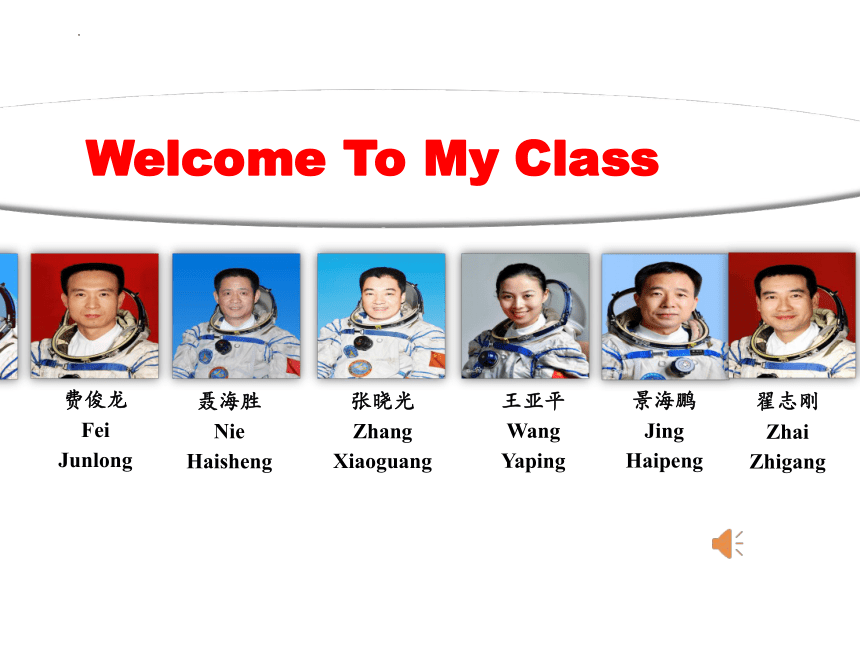 | |
| 格式 | pptx | ||
| 文件大小 | 16.0MB | ||
| 资源类型 | 教案 | ||
| 版本资源 | 人教版(2019) | ||
| 科目 | 英语 | ||
| 更新时间 | 2023-11-21 09:47:47 | ||
图片预览

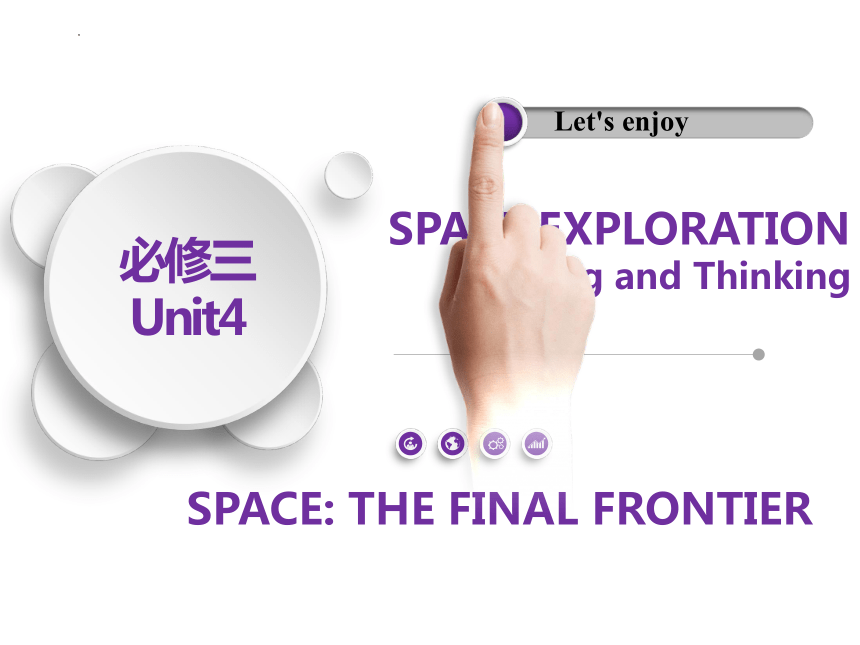
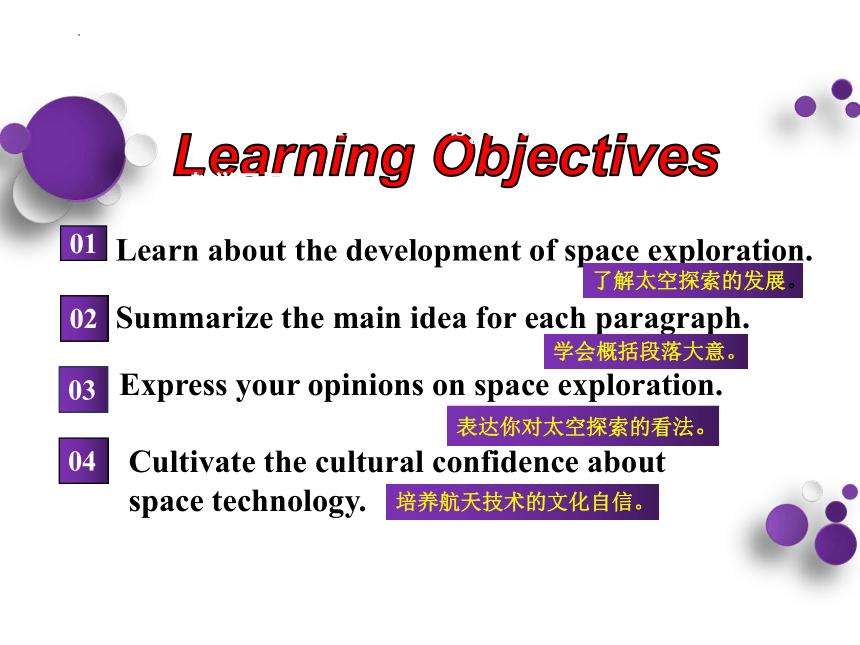

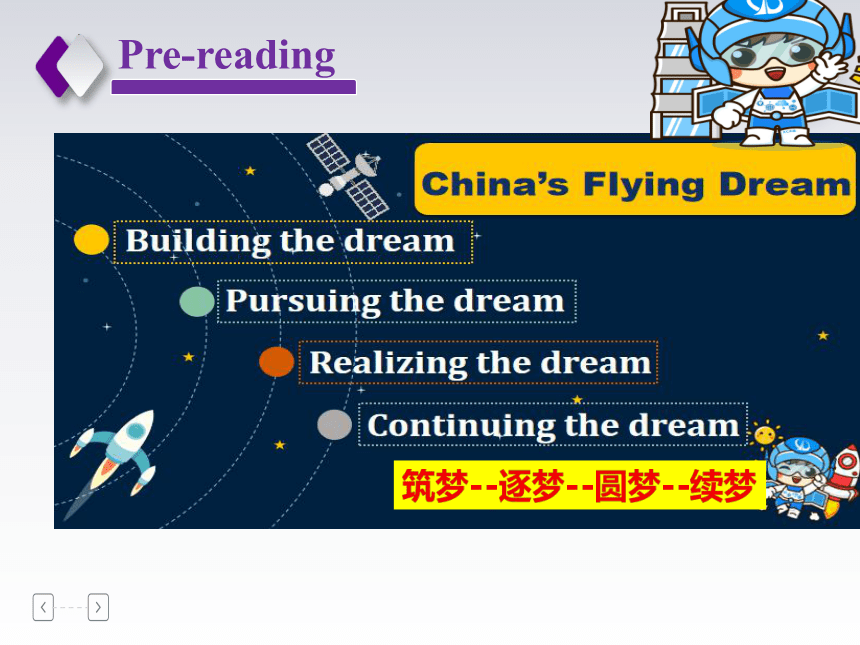
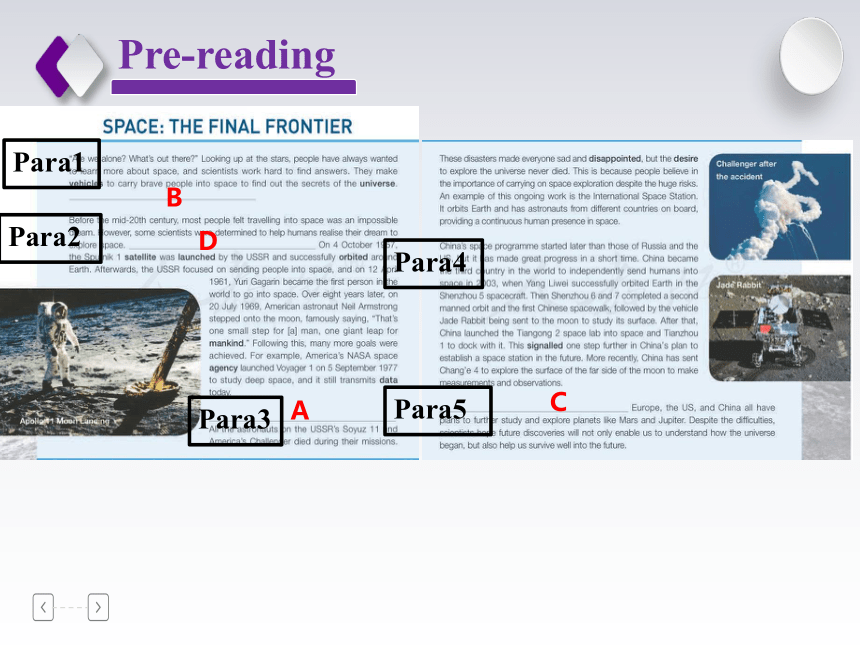


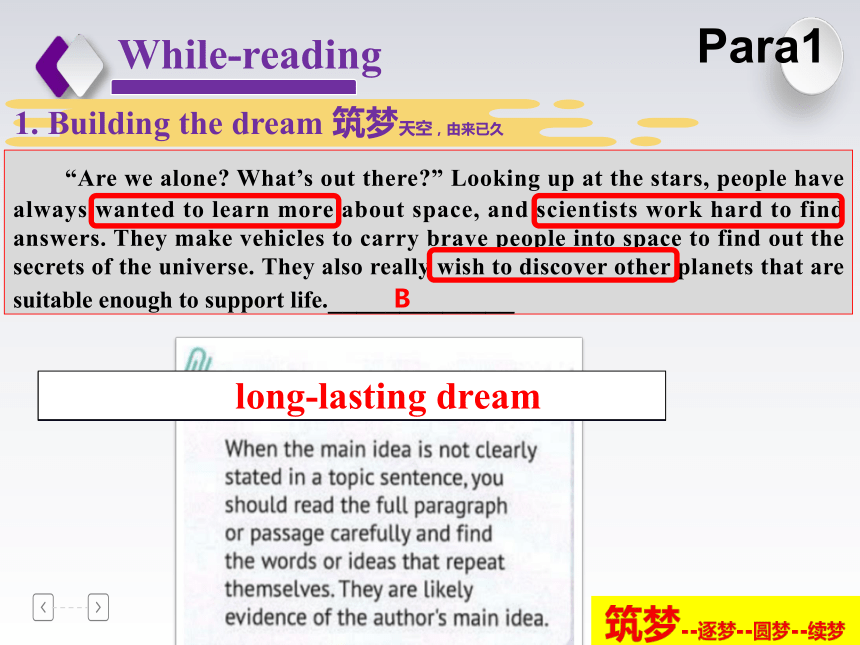
文档简介
(共24张PPT)
杨利伟
Yang Liwei
费俊龙
Fei Junlong
聂海胜
Nie Haisheng
张晓光
Zhang Xiaoguang
王亚平
Wang Yaping
景海鹏
Jing Haipeng
翟志刚
Zhai Zhigang
刘伯明
Liu Boming
刘洋
Liu Yang
刘旺
Liu Wang
陈冬
Chen Dong
杨利伟
Yang Liwei
费俊龙
Fei Junlong
聂海胜
Nie Haisheng
张晓光
Zhang Xiaoguang
王亚平
Wang Yaping
景海鹏
Jing Haipeng
Welcome To My Classe
SPACE: THE FINAL FRONTIER
必修三
Unit4
SPACE EXPLORATION
Reading and Thinking
Let's enjoy
Learning Objectives
Summarize the main idea for each paragraph.
02
Learn about the development of space exploration.
01
Cultivate the cultural confidence about
space technology.
04
Express your opinions on space exploration.
03
Learning Objectives
教学目标
了解太空探索的发展。
学会概括段落大意。
表达你对太空探索的看法。
培养航天技术的文化自信。
Pre-reading
Pre-reading
Pre-reading
筑梦--逐梦--圆梦--续梦
Pre-reading
B
D
A
C
Para1
Para2
Para3
Para4
Para5
While-reading
While-reading
While-reading
1. Building the dream 筑梦天空,由来已久
夸父追日
嫦娥奔月
万户飞天
筑梦--逐梦--圆梦--续梦
While-reading
1. Building the dream 筑梦天空,由来已久
“Are we alone What’s out there ” Looking up at the stars, people have always wanted to learn more about space, and scientists work hard to find answers. They make vehicles to carry brave people into space to find out the secrets of the universe. They also really wish to discover other planets that are suitable enough to support life._____________
B
Para1
People have always had a dream to explore space.
long-lasting dream
筑梦--逐梦--圆梦--续梦
While-reading
2. Pursuing the dream 逐梦之旅,道阻且长
Before the mid-20th century, most people felt travelling into space was an impossible dream. However, some scientists weredetermined to help humans realise their dream to explore space. After many experiments, they succeeded in making rockets that could escape Earth’s gravity.On 4 October 1957, the Sputnik 1 satellite was launched by the USSR and successfully orbited around Earth. Afterwards, the USSR focused on sending people into space, and on 12 April 1961, Yuri Gagarin became the first person in the world to go into space. Over eight years later, on 20 July 1969, American astronaut Neil Armstrong stepped onto the moon, famously saying, “That’s one small step for [a] man, one giant leap for mankind.” Following this, many more goals were achieved. For example, America’s NASA space agency launched Voyager 1 on 5 September 1977 to study deep space, and it still transmits data today.
People’s dream of space exploration after the mid-20th century.
impossible dream
possible dream(reality)
Para2
筑梦--逐梦--圆梦--续梦
The Sputnik(旅伴一号)
the first satellite to
be launched
and orbited around Eearth
Orient 1
(东方一号)
Yuri Gagarin
the first person to space
Apollo 11
(阿波罗 11号)
NeilArmstrong
stepped onto the moon firstly
Voyager 1
(旅行者1号)
to study deep space and still transmits data
The USA
The USSR
VS
Oct 4. 1957
Apr 12. 1961
July 20. 1969
Sep 5. 1977
Para2:How does the writer
support the main idea
By giving examples
筑梦--逐梦--圆梦--续梦
While-reading
2. Pursuing the dream 逐梦之旅,道阻且长
Although scientists try to make sure nothing goes wrong, accidents can still happen. All the astronauts on the USSR’s Soyuz 11 and America’s Challenger died during their missions. These disasters made everyone sad and disappointed , but the desire to explore the universe never died. This is because people believe in the importance of carrying on space exploration despite the huge risks. An example of this ongoing work is the International Space Station. It orbits Earth and has astronauts from different countries on board, providing a continuous human presence in space.
Para3
Despite the accidents and risks, the dream to explore
the universe universe never fade away.
ongoing dream
筑梦--逐梦--圆梦--续梦
the USSR's
Soyuz11(联盟11号)
America's Challenger
(挑战者号)
Para3: accidents
筑梦--逐梦--圆梦--续梦
Disasters
died…
never died
The International Space Station
Desire
the USSR's
Soyuz11(联盟11号)
America's Challenger
(挑战者号)
Para3: accidents
sad anddisappointed…
筑梦--逐梦--圆梦--续梦
While-reading
3. Realizing the dream一飞冲天,圆梦太空
China’s space programme started later than those of Russia and the US, but it has made great progress in a short time. China became the third country in the world to independently send humans into space in 2003, when Yang Liwei successfully orbited Earth in the Shenzhou 5 spacecraft. Then Shenzhou 6 and 7 completed a second manned orbit and the first Chinese spacewalk, followed by the vehicle Jade Rabbit being sent to the moon to study its surface. After that, China launched the Tiangong 2 space lab into space and Tianzhou1 to dock with it. This signalled one step further in China’s plan to establish a space station in the future. More recently, China has sent Chang’e 4 to explore the surface of the far side of the moon to make measurements and observations.
China has made great progress in realizing
the space dream in a short time.
China's space dream
Para4
筑梦--逐梦--圆梦--续梦
2003
then
more recently
after that
followed by
Tiangong 2
Tianzhou1
Furthered the establishment
of a space station.
Chang'e 4 Explored the surface of the far side of the moon.
Para4
Shenzhou 5 Independently
sent humans
into space
Jade Rabbit Studied the surface
Shenzhou6&7
Completed a second manned orbit and
the first Chinese spacewalk
筑梦--逐梦--圆梦--续梦
While-reading
4. Continuing the dream 续梦天空,接续奋斗
The future of space exploration remains bright. Europe, the US, and China all have plans to further study and explore planets like Mars and Jupiter. Despite the difficulties, scientists hope future discoveries will not only enable us to understand how the universe began, but also help us survive well into the future.
Future dream
Para5
筑梦--逐梦--圆梦--续梦
Post-reading
Pre-reading
Critical thinking
Interview:
What’s your dream
Why you have the dream
Reading and thinking
That’s one small step for [a] man, one giant leap for mankind.
---- Neil Armstrong
Apollo 11 Moon Landing
Summary
Para 2.
Achievements of American and Soviet
Para 3.
Space exploration continues in spite of great risks
Para 4.
China’s achievements
Para 5.
The future of space exploration
Space: The Final Frontier
Para1:
People are curious about space
General statement
Supporting
details
Conclusion
Dream
Future
Reality
Homework
According to what you said in our class, write a passage: my dream. Tell us what is your dream and why.
Prediction
Where can we find the passage
A. magazine B. travel journal
C. news report D. science book
a popular science article
(科普文)
A popular science article should contain the following features, except
A. a brief and eye-catching title
B. related pictures
C. difficult language
D. the presentation of the results
E. the analysis of the procedure
F. the backgroud information at the beginning
While-reading
What is the author’s attitude of space exploration
pessimistic
disappointed
C. puzzled
D. positive
Read para. 5 and choose the correct answer.
悲观的
失望的
困惑的
积极的
Tips:观点态度题攻略
表中立客观的:objective, neutral, indifferent
表赞同或支持的:positive, approval, optimistic, hopeful
表否定或批评:negative, disapproval, critical, pessimistic, doubtful
熟悉常用词汇,全面理解文章的内容和中心恩想抓住关键词句,抓住体现人物观点态度的关键句或列举的事例注意流露作者思想倾向或感彩的形容词、副词等。
4. Continuing the dream 续梦天空,接续奋斗
杨利伟
Yang Liwei
费俊龙
Fei Junlong
聂海胜
Nie Haisheng
张晓光
Zhang Xiaoguang
王亚平
Wang Yaping
景海鹏
Jing Haipeng
翟志刚
Zhai Zhigang
刘伯明
Liu Boming
刘洋
Liu Yang
刘旺
Liu Wang
陈冬
Chen Dong
杨利伟
Yang Liwei
费俊龙
Fei Junlong
聂海胜
Nie Haisheng
张晓光
Zhang Xiaoguang
王亚平
Wang Yaping
景海鹏
Jing Haipeng
Welcome To My Classe
SPACE: THE FINAL FRONTIER
必修三
Unit4
SPACE EXPLORATION
Reading and Thinking
Let's enjoy
Learning Objectives
Summarize the main idea for each paragraph.
02
Learn about the development of space exploration.
01
Cultivate the cultural confidence about
space technology.
04
Express your opinions on space exploration.
03
Learning Objectives
教学目标
了解太空探索的发展。
学会概括段落大意。
表达你对太空探索的看法。
培养航天技术的文化自信。
Pre-reading
Pre-reading
Pre-reading
筑梦--逐梦--圆梦--续梦
Pre-reading
B
D
A
C
Para1
Para2
Para3
Para4
Para5
While-reading
While-reading
While-reading
1. Building the dream 筑梦天空,由来已久
夸父追日
嫦娥奔月
万户飞天
筑梦--逐梦--圆梦--续梦
While-reading
1. Building the dream 筑梦天空,由来已久
“Are we alone What’s out there ” Looking up at the stars, people have always wanted to learn more about space, and scientists work hard to find answers. They make vehicles to carry brave people into space to find out the secrets of the universe. They also really wish to discover other planets that are suitable enough to support life._____________
B
Para1
People have always had a dream to explore space.
long-lasting dream
筑梦--逐梦--圆梦--续梦
While-reading
2. Pursuing the dream 逐梦之旅,道阻且长
Before the mid-20th century, most people felt travelling into space was an impossible dream. However, some scientists weredetermined to help humans realise their dream to explore space. After many experiments, they succeeded in making rockets that could escape Earth’s gravity.On 4 October 1957, the Sputnik 1 satellite was launched by the USSR and successfully orbited around Earth. Afterwards, the USSR focused on sending people into space, and on 12 April 1961, Yuri Gagarin became the first person in the world to go into space. Over eight years later, on 20 July 1969, American astronaut Neil Armstrong stepped onto the moon, famously saying, “That’s one small step for [a] man, one giant leap for mankind.” Following this, many more goals were achieved. For example, America’s NASA space agency launched Voyager 1 on 5 September 1977 to study deep space, and it still transmits data today.
People’s dream of space exploration after the mid-20th century.
impossible dream
possible dream(reality)
Para2
筑梦--逐梦--圆梦--续梦
The Sputnik(旅伴一号)
the first satellite to
be launched
and orbited around Eearth
Orient 1
(东方一号)
Yuri Gagarin
the first person to space
Apollo 11
(阿波罗 11号)
NeilArmstrong
stepped onto the moon firstly
Voyager 1
(旅行者1号)
to study deep space and still transmits data
The USA
The USSR
VS
Oct 4. 1957
Apr 12. 1961
July 20. 1969
Sep 5. 1977
Para2:How does the writer
support the main idea
By giving examples
筑梦--逐梦--圆梦--续梦
While-reading
2. Pursuing the dream 逐梦之旅,道阻且长
Although scientists try to make sure nothing goes wrong, accidents can still happen. All the astronauts on the USSR’s Soyuz 11 and America’s Challenger died during their missions. These disasters made everyone sad and disappointed , but the desire to explore the universe never died. This is because people believe in the importance of carrying on space exploration despite the huge risks. An example of this ongoing work is the International Space Station. It orbits Earth and has astronauts from different countries on board, providing a continuous human presence in space.
Para3
Despite the accidents and risks, the dream to explore
the universe universe never fade away.
ongoing dream
筑梦--逐梦--圆梦--续梦
the USSR's
Soyuz11(联盟11号)
America's Challenger
(挑战者号)
Para3: accidents
筑梦--逐梦--圆梦--续梦
Disasters
died…
never died
The International Space Station
Desire
the USSR's
Soyuz11(联盟11号)
America's Challenger
(挑战者号)
Para3: accidents
sad anddisappointed…
筑梦--逐梦--圆梦--续梦
While-reading
3. Realizing the dream一飞冲天,圆梦太空
China’s space programme started later than those of Russia and the US, but it has made great progress in a short time. China became the third country in the world to independently send humans into space in 2003, when Yang Liwei successfully orbited Earth in the Shenzhou 5 spacecraft. Then Shenzhou 6 and 7 completed a second manned orbit and the first Chinese spacewalk, followed by the vehicle Jade Rabbit being sent to the moon to study its surface. After that, China launched the Tiangong 2 space lab into space and Tianzhou1 to dock with it. This signalled one step further in China’s plan to establish a space station in the future. More recently, China has sent Chang’e 4 to explore the surface of the far side of the moon to make measurements and observations.
China has made great progress in realizing
the space dream in a short time.
China's space dream
Para4
筑梦--逐梦--圆梦--续梦
2003
then
more recently
after that
followed by
Tiangong 2
Tianzhou1
Furthered the establishment
of a space station.
Chang'e 4 Explored the surface of the far side of the moon.
Para4
Shenzhou 5 Independently
sent humans
into space
Jade Rabbit Studied the surface
Shenzhou6&7
Completed a second manned orbit and
the first Chinese spacewalk
筑梦--逐梦--圆梦--续梦
While-reading
4. Continuing the dream 续梦天空,接续奋斗
The future of space exploration remains bright. Europe, the US, and China all have plans to further study and explore planets like Mars and Jupiter. Despite the difficulties, scientists hope future discoveries will not only enable us to understand how the universe began, but also help us survive well into the future.
Future dream
Para5
筑梦--逐梦--圆梦--续梦
Post-reading
Pre-reading
Critical thinking
Interview:
What’s your dream
Why you have the dream
Reading and thinking
That’s one small step for [a] man, one giant leap for mankind.
---- Neil Armstrong
Apollo 11 Moon Landing
Summary
Para 2.
Achievements of American and Soviet
Para 3.
Space exploration continues in spite of great risks
Para 4.
China’s achievements
Para 5.
The future of space exploration
Space: The Final Frontier
Para1:
People are curious about space
General statement
Supporting
details
Conclusion
Dream
Future
Reality
Homework
According to what you said in our class, write a passage: my dream. Tell us what is your dream and why.
Prediction
Where can we find the passage
A. magazine B. travel journal
C. news report D. science book
a popular science article
(科普文)
A popular science article should contain the following features, except
A. a brief and eye-catching title
B. related pictures
C. difficult language
D. the presentation of the results
E. the analysis of the procedure
F. the backgroud information at the beginning
While-reading
What is the author’s attitude of space exploration
pessimistic
disappointed
C. puzzled
D. positive
Read para. 5 and choose the correct answer.
悲观的
失望的
困惑的
积极的
Tips:观点态度题攻略
表中立客观的:objective, neutral, indifferent
表赞同或支持的:positive, approval, optimistic, hopeful
表否定或批评:negative, disapproval, critical, pessimistic, doubtful
熟悉常用词汇,全面理解文章的内容和中心恩想抓住关键词句,抓住体现人物观点态度的关键句或列举的事例注意流露作者思想倾向或感彩的形容词、副词等。
4. Continuing the dream 续梦天空,接续奋斗
